Research News
-
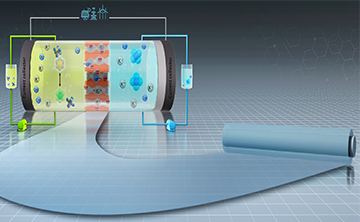 03 28, 2022Low-cost Hydrocarbon Membrane Enables Commercial-scale Flow Batteries for Long-duration Energy StorageScientists realized pilot-scale synthesis and roll-to-roll manufacturing of hydrocarbon membranes with high-performance in alkaline-based flow batteries.Flow batteries are promising for energy storage due to their high safety, high reliability, long cycle life, and high efficiency.The development of commercial-scale flow batteries for long-duration energy storage requires to reduce the cost of flow batteries, especially the cost of ion-exchange membranes.Recently, a research group led by Prof. LI Xianfeng from the Dalian Institute of Chemical Physics (DICP) of the Chinese Academy of Sciences (CAS) realized pilot-scale synthesis and roll-to-roll manufacturing of hydrocarbon membranes with high-performance in alkaline-based flow batteries.This work was published in Joule on March 21.The hydrocarbon membranes for alkaline-based flow batteries with high performance (Image by YUAN Zhizhang)The researchers realized the kilogram-level synthesis of sulfonated poly(ether-ether-ketone) (SPEEK) polymer and demonstrated the pilot-scale roll-to-roll synthesis of SPEEK membrane and their applications in alkaline-based flow batteries.They found that the rigid skeleton and dispersive cation exchange groups enabled the high stability of the membrane in alkaline media, and could confine O-containing species (H2O, OH-, etc.) inside the membrane, resulting in the formation of continuous hydrogen-bonding networks. This favoured the dissociation of H+ in H–O–H (H2O) and transfer from H2O to adjacent OH- ions through a Grotthuss mechanism, thus providing a high OH- conductivity in SPEEK.The membrane was integrated in alkaline zinc-iron flow battery stack with power up to 4 kW, with a high energy efficiency of 85.5% operated at 80 mA/cm2.This work was supported by the National Natural Science Foundation of China, CAS Engineering Laboratory for Electrochemical Energy Storage, and the Youth Innovation Promotion Association of CAS. (Text by YUAN Zhizhang)
03 28, 2022Low-cost Hydrocarbon Membrane Enables Commercial-scale Flow Batteries for Long-duration Energy StorageScientists realized pilot-scale synthesis and roll-to-roll manufacturing of hydrocarbon membranes with high-performance in alkaline-based flow batteries.Flow batteries are promising for energy storage due to their high safety, high reliability, long cycle life, and high efficiency.The development of commercial-scale flow batteries for long-duration energy storage requires to reduce the cost of flow batteries, especially the cost of ion-exchange membranes.Recently, a research group led by Prof. LI Xianfeng from the Dalian Institute of Chemical Physics (DICP) of the Chinese Academy of Sciences (CAS) realized pilot-scale synthesis and roll-to-roll manufacturing of hydrocarbon membranes with high-performance in alkaline-based flow batteries.This work was published in Joule on March 21.The hydrocarbon membranes for alkaline-based flow batteries with high performance (Image by YUAN Zhizhang)The researchers realized the kilogram-level synthesis of sulfonated poly(ether-ether-ketone) (SPEEK) polymer and demonstrated the pilot-scale roll-to-roll synthesis of SPEEK membrane and their applications in alkaline-based flow batteries.They found that the rigid skeleton and dispersive cation exchange groups enabled the high stability of the membrane in alkaline media, and could confine O-containing species (H2O, OH-, etc.) inside the membrane, resulting in the formation of continuous hydrogen-bonding networks. This favoured the dissociation of H+ in H–O–H (H2O) and transfer from H2O to adjacent OH- ions through a Grotthuss mechanism, thus providing a high OH- conductivity in SPEEK.The membrane was integrated in alkaline zinc-iron flow battery stack with power up to 4 kW, with a high energy efficiency of 85.5% operated at 80 mA/cm2.This work was supported by the National Natural Science Foundation of China, CAS Engineering Laboratory for Electrochemical Energy Storage, and the Youth Innovation Promotion Association of CAS. (Text by YUAN Zhizhang) -
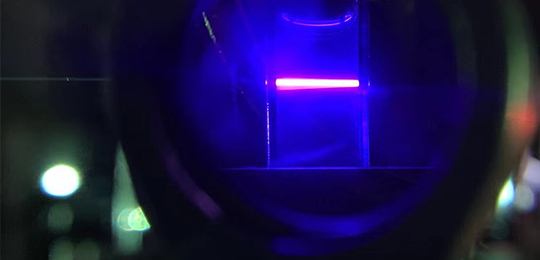 03 25, 2022Rapid Spin-flip in Colloidal Nanocrystals to Generate Molecular TripletsResearchers revealed the mechanism for molecular spin-triplets formation from rapid spin-flip in colloidal nanocrystals and demonstrated its photochemical applications.A research group led by Prof. WU Kaifeng from the Dalian Institute of Chemical Physics (DICP) of the Chinese Academy of Sciences (CAS) revealed the mechanism for molecular spin-triplets formation from rapid spin-flip in colloidal nanocrystals and demonstrated its photochemical applications.The study was published in Chem on March 24.Traditionally, semiconductor spin properties are a territory of physics. Recent developments in solution-grown semiconductor materials, such as lead halide perovskites and colloidal nanocrystals, start to include chemists into this game. But the spin relaxation lifetimes of these materials are still too short (typically a few picoseconds at room temperature) for spintronic and quantum information technology applications.Importantly, however, there is a big field called "molecular photochemistry" that is particularly fond of spin-relaxed molecular triplet states. Photochemists have spent a lot of efforts in the synthesis of special molecules called sensitizers that can produce triplets upon photoexcitation.White-light-driven triplet-fusion photon upconversion and singlet oxygen generation by using nanocrystals to flip the spins to genrate molecular triplets (Image by WU Kaifeng)"We realized that the short spin lifetimes recently measured in colloidal nanocrystals should instead find immediate applications in molecular photochemistry," said Prof. WU.The researchers demonstrated spin-enabled photochemistry using CsPbBr3 nanocrystals surface-anchored with rhodamine B molecules. Using advanced femtosecond laser spectroscopy, they found that excitation of either the nanocrystal or the molecule induced efficient charge separation, and the rapid spin-flip of the carrier inside the nanocrystal enabled the high-yield formation of molecular triplets through charge recombination. In contrast, the conventional mechanism of heavy-atom effect was ruled out for this system.Moreover, using the dual triplet-formation pathways and the complementary spectral coverage of CsPbBr3 and rhodamine B, they achieved efficient white-light-driven molecular triplet photochemistry, including triplet-fusion photon upconversion and singlet oxygen generation."This study opens a new avenue for photochemical applications of solution-processed semiconductor materials," said Prof. WU. "It may inspire the use of the spin properties of these low-cost materials in more fields."The above work was supported by the National Natural Science Foundation of China, the Ministry of Science and Technology of China, and CAS.
03 25, 2022Rapid Spin-flip in Colloidal Nanocrystals to Generate Molecular TripletsResearchers revealed the mechanism for molecular spin-triplets formation from rapid spin-flip in colloidal nanocrystals and demonstrated its photochemical applications.A research group led by Prof. WU Kaifeng from the Dalian Institute of Chemical Physics (DICP) of the Chinese Academy of Sciences (CAS) revealed the mechanism for molecular spin-triplets formation from rapid spin-flip in colloidal nanocrystals and demonstrated its photochemical applications.The study was published in Chem on March 24.Traditionally, semiconductor spin properties are a territory of physics. Recent developments in solution-grown semiconductor materials, such as lead halide perovskites and colloidal nanocrystals, start to include chemists into this game. But the spin relaxation lifetimes of these materials are still too short (typically a few picoseconds at room temperature) for spintronic and quantum information technology applications.Importantly, however, there is a big field called "molecular photochemistry" that is particularly fond of spin-relaxed molecular triplet states. Photochemists have spent a lot of efforts in the synthesis of special molecules called sensitizers that can produce triplets upon photoexcitation.White-light-driven triplet-fusion photon upconversion and singlet oxygen generation by using nanocrystals to flip the spins to genrate molecular triplets (Image by WU Kaifeng)"We realized that the short spin lifetimes recently measured in colloidal nanocrystals should instead find immediate applications in molecular photochemistry," said Prof. WU.The researchers demonstrated spin-enabled photochemistry using CsPbBr3 nanocrystals surface-anchored with rhodamine B molecules. Using advanced femtosecond laser spectroscopy, they found that excitation of either the nanocrystal or the molecule induced efficient charge separation, and the rapid spin-flip of the carrier inside the nanocrystal enabled the high-yield formation of molecular triplets through charge recombination. In contrast, the conventional mechanism of heavy-atom effect was ruled out for this system.Moreover, using the dual triplet-formation pathways and the complementary spectral coverage of CsPbBr3 and rhodamine B, they achieved efficient white-light-driven molecular triplet photochemistry, including triplet-fusion photon upconversion and singlet oxygen generation."This study opens a new avenue for photochemical applications of solution-processed semiconductor materials," said Prof. WU. "It may inspire the use of the spin properties of these low-cost materials in more fields."The above work was supported by the National Natural Science Foundation of China, the Ministry of Science and Technology of China, and CAS. -
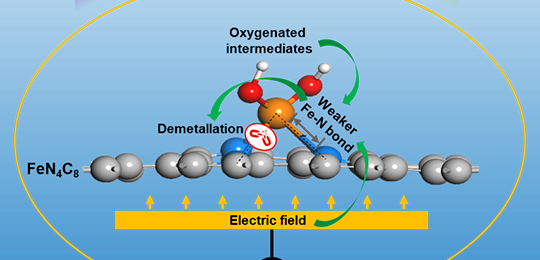 03 22, 2022Researchers Reveal Degradation Mechanism of Non-precious Metal Catalysts for Fuel Cells
03 22, 2022Researchers Reveal Degradation Mechanism of Non-precious Metal Catalysts for Fuel Cells
The development of efficient non-precious metal catalysts (NPMCs) can help reduce the cost of fuel cells and accelerate their commercialization.
At present, non-precious metal catalysts suffer from poor stability in proton exchange membrane fuel cells, and their degradation mechanism at the molecular scale is unclear.
Recently, a research group led by Prof. SUN Gongquan Sun and Prof. WANG Suli collaborated with Prof. WANG Junhu's group from the Dalian Institute of Chemical Physics (DICP) of the Chinese Academy of Sciences (CAS) revealed the degradation mechanism of Fe-N-C-type NPMCs.
This work was published in Applied Catalysis B: Environmental on March 4.
The influence of structure and structural evolution of active site on the demetallation of Fe-N-C is investigated by the end-of-test/in-situ M?ssbauer spectroscopy and ab initio molecular dynamics simulation (Image by XU Xinlong)
The researchers found that D1 was the main active site for oxygen reduction reaction and the demetallation was responsible for the degradation of Fe-N-C. The degradation was initially rapid but slow afterward, which could be explained by the different activity and stability of various FeN4 sites.
Moreover, they revealed that the adsorption of oxygenated intermediate and the motivation of electric field could further weaken the Fe-N bond in FeN4, leading to more severe demetallation. The faster degradation of Fe-N-C under higher potential was due to the stronger adsorption and field intensity.
This work provides insight into the degradation mechanism of Fe-N-C at the molecular level. It can work as the guidance for the future development of stable NPMCs in fuel cell devices.
This work was supported by the National Natural Science Foundation of China, and the Postdoctoral Science Foundation of China. (Text by XU Xinlong) -
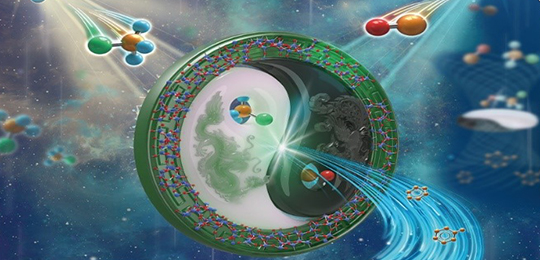 03 21, 2022New Strategy Enhances Aromatics Selectivity in Methane ConversionScientists developed an efficient reaction strategy for the transformation of methane into aromatics by coupling of CH3Cl with CO over H-zeolites.
03 21, 2022New Strategy Enhances Aromatics Selectivity in Methane ConversionScientists developed an efficient reaction strategy for the transformation of methane into aromatics by coupling of CH3Cl with CO over H-zeolites.
Methane, the main constituent in shale gas and flammable ice, is expected to replace petroleum to produce high value-added chemicals such as aromatics. Methane is relatively highly inert, which is caused by the high C-H bond strength and supersymmetric structure and hinders its applications.
Recently, a research team led by Prof. LIU Zhongmin and Prof. ZHU Wenliang from the Dalian Institute of Chemical Physics (DICP) of the Chinese Academy of Sciences (CAS) developed a strategy for the transformation of methane into aromatics by coupling of CH3Cl with CO over H-zeolites.
This study was published in Angew. Chem. Int. Ed. on Feb. 1. It was selected as Very Important Paper and inside back cover.
Highly Enhanced Aromatics Selectivity by Coupling of Chloromethane and Carbon Monoxide over H-ZSM-5 (Image by FANG Xudong)
The researchers used H-ZSM-5 as catalysts to achieve high aromatics selectivity as well as high selectivity of benzene, toluene, and xylene (BTX).
They found that the selectivity to aromatics increased from 39.0% to 79.3% after introducing CO, and corresponding BTX selectivity increased from 17.7% to 48.0% at 2.0 MPa, 673 K. After optimizing reaction conditions, the aromatics selectivity reached as high as 82.2%, and BTX selectivity as high as 59.3%.
Moreover, they discovered that 2,3-dimethyl-2-cyclopentene-1-one (DMCPO) was generated from acetyl groups and olefins. And CO was proven to be inserted into the DMCPO and aromatics rings.
Then they proposed a new aromatization mechanism, including the formation of the above intermediates, which conspicuously weakened the hydrogen transfer reaction, resulting in an increase in aromatics selectivity and a drop in alkanes.
"Our study broadens approaches towards the transformation of methane into chemicals, and ensure the sustainable development of natural gas in an environmental pathway," said Prof. ZHU.
The study was supported by the National Natural Science Foundation of China, the Strategic Priority Research Program of CAS, the Dalian High-Level Talent Innovation Support Program, and National Special Support Program for High-Level Talents. (Text by FANG Xudong and LIU Hongchao) -
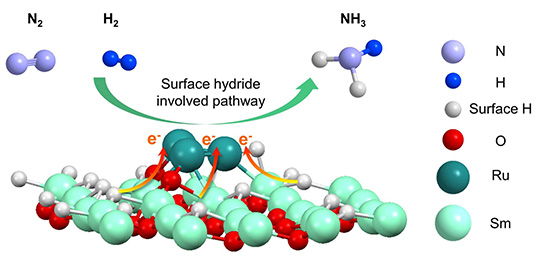 03 18, 2022Synergistic Effect of Surface Hydride Species and Ru Clusters Improves Efficiency of Ammonia SynthesisScientists discovered that samarium hydride (Sm-H) species, in situ generated on the surface of Ru clusters/Sm2O3 catalyst under reaction conditions, could work synergistically to enhance the catalytic activity of Ru clusters for ammonia synthesis.
03 18, 2022Synergistic Effect of Surface Hydride Species and Ru Clusters Improves Efficiency of Ammonia SynthesisScientists discovered that samarium hydride (Sm-H) species, in situ generated on the surface of Ru clusters/Sm2O3 catalyst under reaction conditions, could work synergistically to enhance the catalytic activity of Ru clusters for ammonia synthesis.
A research team led by Prof. CHEN Ping and Associate Prof. LIU Lin from the Dalian Institute of Chemical Physics (DICP) of the Chinese Academy of Sciences (CAS), in collaboration with Associate Prof. WU Anan from Xiamen University, discovered that samarium hydride (Sm-H) species, in situ generated on the surface of Ru clusters/Sm2O3 catalyst under reaction conditions, could work synergistically to enhance the catalytic activity of Ru clusters for ammonia synthesis.
This study was published in ACS catalysison Jan. 28.
Schematic illustrations of the synergistic effect of surface hydride species and Ru clusters for catalytic ammonia synthesis reaction (Image by ZHANG Xilun)
The researchers synthesized sub-nanometer Ru clusters on Sm2O3 (Ru clusters/Sm2O3) and investigated its catalytic performance for ammonia synthesis. "Under mild reaction conditions, this catalyst showed good activity as well as high stability, thermal stability, and water-tolerant stability," said Prof. CHEN.
Furthermore, experimental and theoretical results revealed that Sm2O3 featuring surface Sm-H species could regulate the electronic structure of Ru clusters, making the catalyst active for hydrogen and nitrogen activation. And the Sm-H species on the Ru/Sm2O3 catalyst could directly participate in the formation of ammonia, rendering the catalyst exceptionally active in ammonia synthesis.
"The discovery of the synergy role of surface hydride species can deepen the molecular-level understanding of active sites and reaction mechanism of Ru-based catalysts during the ammonia synthesis process," said Prof. CHEN, "and it also provides an opportunity for the rational design of efficient Ru-based ammonia synthesis catalysts under mild conditions."
This work was supported by the National Natural Science Foundation of China, Dalian National Laboratory for Clean Energy, and K. C. Wong Education Foundation. (Text by ZHANG Xilun and LIU Lin) -
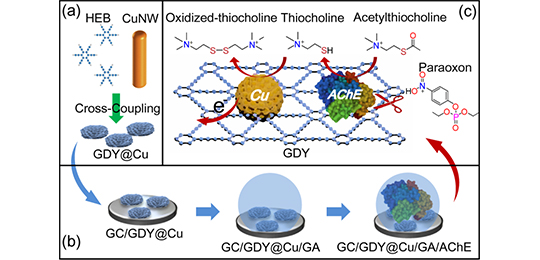 03 17, 2022Researchers Develop Electrochemical Biosensor for Interference-free Detection of Organophosphorus PesticidesScientists have developed a high-performance electrochemical biosensor for the interference-free detection of OPs.
03 17, 2022Researchers Develop Electrochemical Biosensor for Interference-free Detection of Organophosphorus PesticidesScientists have developed a high-performance electrochemical biosensor for the interference-free detection of OPs.
Organophosphorus pesticides (OPs), a class of lethalnerve agents widely used in agriculture, pose an extreme threat to human health and environment.
Electrochemical biosensor based on the inhibition of acetylcholinesterase (AChE) has been regarded as an ideal tool for rapid detection of OPs, but it is suffered from the sluggish electrode kinetics and high oxidation potential toward signal species.
Recently, a research group led by Prof. LU Xianbo and Prof. CHEN Jiping from the Dalian Institute of Chemical Physics (DICP) of the Chinese Academy of Sciences (CAS) has developed a high-performance electrochemical biosensor for the interference-free detection of OPs.
This study was published in Biosensors and Bioelectronics on Feb. 21.
Schematic illustrations of the biosensor fabrication and OPs detection (Image by NIU Kai)
The researchers synthesized a nanocomposite of ultrafine Cu quantum dots (QD) uniformly loaded on three-dimensional ultrathin graphdiyne (GDY) nanosheets (denoted as Cu@GDY) via a one-step strategy. Cu@GDY showed a high density of active sites with persistent stability.
Then, they fabricated an AChE biosensor based on Cu@GDY to detect OPs and found that the results of the Cu@GDY nanocomposite could amplify the electrochemical signal and reduce the oxidation potential for OPs.
Moreover, they investigated the potential electro-catalysis mechanism and structure-activity relationships of the proposed biosensor through characterizing the kinetics of electrode reaction, the source of active sites, and the interaction between signal species and active site. "After theoretical derivation and experimental verification of enzyme inhibition kinetics, the biosensor was verified to have high sensitivity to detect OPs," said Prof. LU.
This work was supported by the National Natural Science Foundation of China, and the Dalian Science and Technology Innovation Fund. (Text by NIU Kai)